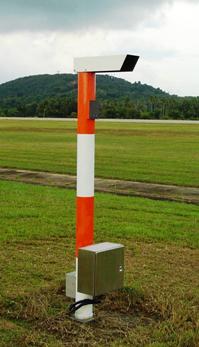
Runway visual range
Encyclopedia

Aviation
Aviation is the design, development, production, operation, and use of aircraft, especially heavier-than-air aircraft. Aviation is derived from avis, the Latin word for bird.-History:...
meteorology
Meteorology
Meteorology is the interdisciplinary scientific study of the atmosphere. Studies in the field stretch back millennia, though significant progress in meteorology did not occur until the 18th century. The 19th century saw breakthroughs occur after observing networks developed across several countries...
to define the distance over which a pilot of an aircraft on the centreline of the runway can see the runway surface markings delineating the runway or identifying its centre line. RVR is normally expressed in feet or meters.
RVR is used as one of the main criteria for minima on instrument approach
Instrument approach
For aircraft operating under instrument flight rules , an instrument approach or instrument approach procedure is a series of predetermined maneuvers for the orderly transfer of an aircraft under instrument flight conditions from the beginning of the initial approach to a landing, or to a point...
es, as in most cases a pilot must obtain visual reference of the runway to land an aircraft. The maximum RVR reading is 2,000 metres or 6,000 feet, above which it is not significant and thus does not need to be reported. RVRs are provided in METAR
METAR
METAR is a format for reporting weather information. A METAR weather report is predominantly used by pilots in fulfillment of a part of a pre-flight weather briefing, and by meteorologists, who use aggregated METAR information to assist in weather forecasting....
s and are transmitted by air traffic controller
Air traffic controller
Air traffic controllers are the people who expedite and maintain a safe and orderly flow of air traffic in the global air traffic control system. The position of the air traffic controller is one that requires highly specialized skills...
s to aircraft making approaches to allow pilots to assess whether it is prudent and legal to make an approach.
RVR is also the main criteria used to determine the category of visual aids that are installed at an airport. The International Civil Aviation Organization
International Civil Aviation Organization
The International Civil Aviation Organization , pronounced , , is a specialized agency of the United Nations. It codifies the principles and techniques of international air navigation and fosters the planning and development of international air transport to ensure safe and orderly growth...
ICAO stipulates that for RVR values above 550 m, CAT I lighting shall be installed, if RVR is between 300 m and 549 m then CAT II lighting is required. CAT IIIa is installed for RVR values between 175 m and 300 m. CAT IIIb is required for RVR values between 50 m and 175 m while there is no RVR limitation for CAT IIIc visual aids.
Originally RVR was measured by a person, either by viewing the runway lights from the top of a vehicle parked on the runway threshold, or by viewing special angled runway lights from a tower at one side of the runway. The number of lights visible could then be converted to a distance to give the RVR. This is known as the human observer method and can still be used as a fall-back.
Today most airports use Instrumented Runway Visual Range or IRVR, which is measured by devices called forward scatter meters which provide simplified installation as they are integrated units and can be installed as single unit(s) at a critical location along the runway or transmissometer
Transmissometer
A transmissometer is an instrument for measuring the extinction coefficient of the atmosphere, and for the determination of visual range. It operates by sending a narrow, collimated beam of energy through the propagation medium...
s which are installed at one side of a runway relatively close to its edge. Normally three transmissometers are provided, one at each end of the runway and one at the mid-point. In the US, Forward Scatter RVRs are replacing transmissometers at most airports. According to the US Federal Aviation Administration: "There are approximately 279 RVR systems in the NAS, of which 242 are forward scatter NG RVR Systems and 34 are older Transmissometer Systems."

